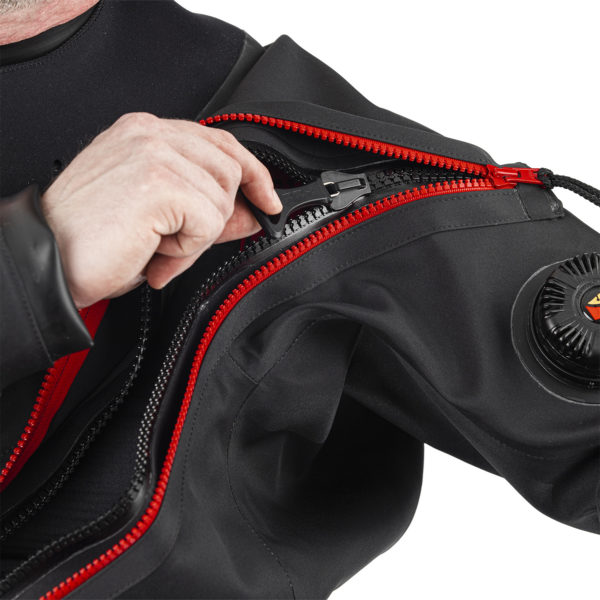Drysuit Repairs & Alterations
If you are a diver that feels the cold, or if you just want to dive in the clear waters of winter, a perfect-fitting drysuit is essential!
Dive Doctor has been supplying and repairing drysuits for over 25 years. We are a supplier to the Navy, Police, DOC, NIWA, Customs, Universities, and Dive shops, as well as individuals.
The Dive Doctor offers a full range of drysuits by leading manufacturers including:
Drysuits: Cressi Sub®, Aqualung®, Otter®, Viking®, Diverite®, Fourth Element®, Waterproof, Mares
We can fit a range of accessories to suits, including kevlar bum and knee pads, soft socks, P-valves, pockets, Sitech® silicone seals, Apeks valves® and scuppers.
Click on the brands above for more details.
Dive Doctor specialises in the repair of all brands of drysuits, sailing jackets and kayak jackets. We offer a top-quality, cost-effective repair and alteration service to all brands and types of wetsuits including triathlon, surfing, freediving, spearfishing and diving suits. We can also alter or modify any brand of wetsuit to provide a better fit for you. If you have a drysuit that is “not dry”, give us a call we can replace zips, boots, seals, and also repair leaks.
If you have a drysuit in need of repair please click on the repair form and send it with the suit. We will be in contact with you to discuss the options.
All about Drysuits:
Commercial divers, the military and technical divers have been using drysuits for many years and the information below will give you details on the options available:
Benefits of Drysuits
Thermal protection is very important to the diver as water conducts heat away from the body approximately 25 times faster than air. Few divers realise how important this thermal stress may be to their safety and performance. Even if you don’t feel the cold in a wetsuit, you may be losing heat to the water faster than it can be replaced. A Drysuit offers the best, most cost-effective way for the diver to stay warm.
- Drysuits are easily and very quickly donned and removed. No more struggling into a wetsuit and having that constricted feeling.
- Drysuits are as much to do with the ease of diving as the water temperature.
- The warm and comfortable diver will be a clearer thinking one, whose air consumption is likely to improve.
- Because the vital organs within the torso are warm the extremities of hands and feet retain circulation and stay warmer.
- The Drysuit diver really scores on repeat dives when the suit is still just easily and quickly donned. No more fighting your way into that damp wetsuit.
- The coldness encountered by wetsuit divers on repeat dives does not affect the Drysuit diver since the body’s core temperature of 37C will not have been as affected by earlier dives as that of a wetsuit diver.
- The Drysuit diver has the added bonus that because the body is dry, of being far less affected by wind chill factors.
- In Drysuits you will want to dive all the year round. Three winter dives a day are a reality!
Broadly speaking, there are two types of drysuits: Shell suits (also known as membrane suits) and neoprene suits.
Shell suits typically consist of one or more layers of durable fabric such as polyurethane-coated nylons, vulcanized rubber or crushed neoprene (neoprene without air cells). Trilaminate shells are a popular option; these consist of three layers of material such as nylon, butyl rubber and another layer of nylon bonded together to form a tough waterproof barrier.
Shell suits, particularly those made with trilaminate, tend to be lightweight and flexible and can therefore be worn all day without physically exhausting the diver. They are easier to don than neoprene suits and dry faster. In addition, because the shell itself offers minimal thermal protection, the suit is ideal for diving over a broad range of water temperatures, from near freezing up to 25 degrees, depending on the undergarments used.
Constructed of the same material as wetsuits, older-style foam neoprene drysuits are typically cut more snugly to reduce drag. Because the warmth comes primarily from the neoprene itself, these suits usually require fewer or lighter undergarments. They require more weight than shell suits and, like wetsuits, suffer from diminished insulation at deeper depths. They are also used in specific applications like recreational dive instruction and dry caving where sumps must be negotiated. They are usually less expensive than shell suits, making them an attractive choice for some beginning drysuit divers.
Selecting Suitable Options:
Because drysuits are typically made of tough fabrics, they tend to be roomy which means less stretching and straining of the material, making them longer lasting. They come in a variety of styles including front and rear zip options. Many divers find a buddy’s help makes suiting up much easier.
Drysuits’ watertight neck and wrist seals come in three varieties: latex ,neoprene and silicone. Latex and silicone can stretch up to 400 percent, generally creating a better seal and they are easier to put on and take off. They do require more careful handling though, and they have a shorter life expectancy, requiring replacement when worn out. Neoprene seals, which usually include a Lycra lining, expand by only about 100 percent and are harder to get on and off, but they hold up longer and can take more abuse. One of the latest innovations in drysuits are the Sitech® silicone seals which clip into place rather than being glued, allowing them to be changed out in the field if necessary.
Suitable undergarments are critical to being warm both during the dive and afterwards. Be sure to select undergarments designed for the water temperature you plan to dive in.



